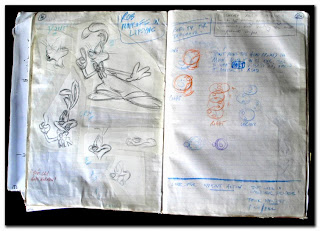What kind of preparation should students do before starting with us in our Autumn classroom at Animation Apprentice on September 7th? We don't want to spoil your summer, but it's always good to get a little bit of a head start.
Below is a brief list of stuff to get you under way. It's not comprehensive, and you don't have to do all of it, but tick off a few of the things on this list and you will be a making a great start on your animation career.
 |
| The Animator's Survival Kit - the best book on animation? |
First, here is a reading list to get you started. Buy a couple of these books online or check them out from your local library.
- The Animator's Survival Kit. We recommend that any serious student of animation should buy a copy of The Animator's Survival Kit, by Richard Williams. It is now the standard textbook for animators and easily the most comprehensive book available for learning animation.
- The Illusion of Life. The Illusion of Life was written by Disney animation legends Frank Thomas and Ollie Johnstone, and represents the accumulation of knowledge of the first "Golden Age" of Disney animation. An invaluable resource.
- Animation Methods by David Rodriguez is a very, very good book on learning animation in Maya. It's a book that focuses primarily on 3D Character Animation, a step-by-step guide for learning Maya, and the Maya animation tools. It is probably the best book out there for learning animation in Maya.
- Cartoon Animation. Cartoon Animation by Preston Blair was the first available book on animation, and has been in print since the early 1950s, regularly updated since then. Still full of very useful material.
- Timing for Animation by Harold Whittaker and John Halas is another very useful book on animation. It was first written some years ago but was recently updated and edited by former Animation Guild President Tom Sito.
- Character Animation Crash Course. The Character Animation Crash Course by Eric Goldberg is an excellent resource by one of the most talented 2D animators in the world - the man behind the genie in Disney's Aladdin.
- The Complete Digital Animation Course. The Complete Digital animation Course by Andy Wyatt is a very useful overall guide to all the processes involved in digital animation and film-making. Especially good for the technical bits that the older books don't cover.
OK - so you've bought a book or two - what else? The next thing to do, assuming you have a laptop at home, is get yourself a free copy of Autodesk Maya, and open it up. Maya is the main software we animate with, nowadays it's the industry standard. We recommend starting out with Maya 2015, not 2016, since the 2016 release has changed the interface a good deal.
Below is a free tutorial in the Maya tools (there are tons of similar ones) hosted at YouTube, to get you started.
Don't be daunted - just take a quick look! It does look a bit confusing at first but it's good to get familiar with the layout, and learn where the main hotkeys are, and how the interface works. You can register and get a free Maya student license here.
Once you have done that, take a look at the week 1 videos at the website. The week 1 videos are all free and this gives you a general introduction to the medium of animation, helping you to get familiar with the language of the medium.
 |
| Fill sketchbooks! |
Other useful things you can do include going to life drawing classes, and especially filling a sketch book with sketches, doodles and ideas.
Being able to express an idea in a simple sketch is still a very useful skill, even in the digital age. We don't expect our students to be brilliant draftsmen, but we do expect you to be able to pick up a pencil and do a sketch - even if it's a crude one.
All great ideas begin with a drawing - however simple and basic.
If you do some or all the things on this list - you will have a great head start with us on September 7th! We look forward to meeting you!
----Alex
To find out more about Animation Apprentice, click here for a link to Frequently Asked Questions. To sign up for our next classroom at Animation Apprentice, follow this link.




No comments:
Post a Comment